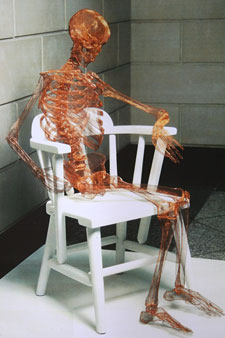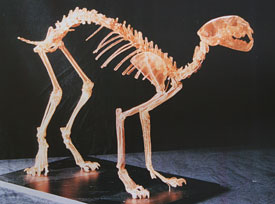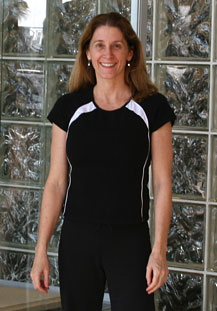Jimenez Sculpture: The Beauty Is in The Copper Detail
 Copper wire anatomical sculpture by Cynthia Jimenez.
Copper wire anatomical sculpture by Cynthia Jimenez. Photograph courtesy of Cynthia Jimenez
While Halloween’s signature skeletons, pumpkins, and witches haunt neighborhoods around the country this time of year, one copper artist has taken the artistic beauty of the human skeleton to the highest level of structural perfection. Her "Skeletons of Expression" are brilliantly amazing, anatomically-perfect, and woven with thousands of threads of tiny copper wire.
Cynthia Jimenez, born in Kansas and graduated from the University of Kansas with a Bachelors in Fine Arts in Design, was challenged by three dimensional sculpture as early as high school. She sold her first commission at age 17.
"I made an original life-size human work in a college sculpture class and used chicken wire to shape the body,” she recalls. “It worked, but it wasn't elegant.”
After graduating, Jimenez traveled and studied in South America for several years living with missionaries and Quechua Indians in secluded regions of the Andes. Returning to the United States, she produced architectural stained glass and stone mosaics for churches and corporations throughout the Southeast.
Then, an unexpected turn of events changed her artistic perspective.
"A car accident that resulted in severe injuries changed the course of my life because of the symptoms I had from my head injury,” she says. “I couldn't get any answers from the medical community except being told I should be glad the symptoms weren't worse. I didn't believe or accept that I wouldn't heal or get better so I set down this educational/artistic road to heal myself. It was successful."
To help heal from chronic effect of the injuries, Jimenez became licensed in massage therapy from the Reese Institute of Massage Therapy. She received certification to teach kinesthetic anatomy nationally and for ten years led classrooms of artists and healthcare practitioners to build the body's muscles in clay on a skeletal model. She also learned osteological preparation and assisted courses in human dissection at the University of South Florida in Tampa for seven years to further enhance her understanding of anatomy and physiology. She has studied the musculoskeletal system for more than 25 years, is currently certified in and provides personal training for women. This education has heavily influenced her artwork.
 Copper wire anatomical sculpture by Cynthia Jimenez.
Copper wire anatomical sculpture by Cynthia Jimenez. Photograph courtesy of Cynthia Jimenez
Jimenez has sculpted human and animal forms. Her bronze horse sculptures simplified the complexity of their systems but still demonstrated her complete understanding of their structure.
"It was by accident that I started working with copper," Jimenez admits. "One day I was shopping in Orlando at a place called SkyCraft Parts and Surplus when I found a large roll of perforated copper. I bought it and started shaping all the bones of the human skeleton. Being perforated, it allowed for more stretch and compression so I could get the detail I wanted. I also admired its strength and that it did not tear easily. Another property copper has is its springiness. Once I have the skeleton put together, if movement or vibration is added it will react with a lifelike response."
Jimenez also relies on coppers flexibility to connect the individual pieces of her work.
"My special tools are my fingers and some old wooden clay tools, a burnishing tool, scissors and lots of different shaped pliers,” she says. “I use copper wire to sew or tie the seams together after I have shaped the perforated copper sheet into the bone. I then use the copper wire to tie the bones together and I use copper alloy-type rod for the internal armature that I bend to follow the form of the bones so the armatures are hidden as much as possible. There are different challenges to solve with each sculpture depending upon the pose I have selected. The technique is slow, tedious and requires enormous patience. The average time to complete each life-size sculpture is a year. They undergo their own natural patina process though I have used gold leaf, silver leaf and paint on some."
 Sculptor Cynthia Jimenez.
Sculptor Cynthia Jimenez.Photograph courtesy of Cynthia Jimenez
Jimenez has a studio in her Florida home where she builds the life-size skeleton sculptures.
“These works are a personal pursuit,” she reveals. “I have increased my knowledge tremendously by creating them and they are educating people. The sculpture BALANCE that is at the University of Central Florida is positioned in the yoga pose called the scorpion. Because of the way I designed it and the springiness of the material, the sculpture is allowed to move back and forth as if finding its balance."
In the same location is PLAY, a life-size reclining figure. TIME, depicting a skeleton sitting in a chair looking at his wrist and WORK, which shows a standing skeleton in front of a metal stomp shear, are in private collections. After a piece is completed in her studio, it is then vanned off to wherever it is going. Jimenez accepts commissions for private collections, universities and corporations.
“At the Medical School they used a gurney to take each skeleton into the building,” she says. “I got a kick out of that."
Numerous artistic works by Jimenez have been exhibited in Florida venues such as Gallery at Avalon Island, Albertson-Peterson Art, Epcot Flower and Garden Festival, Maitland Art Center, Downtown Sculpture Program (Orlando), Evolution Gallery, Atlantic Center for The Arts, Barnett Bank Gallery, William Kenton Gallery, Crealde School of Art and the Winter Park Library.
 Copper wire anatomical sculpture.
Copper wire anatomical sculpture.Photograph courtesy of Cynthia Jimenez
Outside Florida, her displays have been included at Alder Gallery Oregon), Artwest Gallery (Wyoming), and Center for The Cultural Arts (Kansas). Some of these were horse sculptures which she started creating in copper, then switched to bronze. Her horse sculpture, GUARDIAN, is made of bronze rod. Jimenez also creates miniature paintings.
However, the only place her "Skeletons of Expression" can be seen right now is the University of Central Florida. BALANCE and PLAY are on the 4th floor Medical Education Building in the Health Sciences Campus at Lake Nona. Florida BOBCAT is also at the anatomy lab of the UCF Medical School. BAD TO THE BONE is on display at the Wayne Densch Athletic Sports Center there. The positive response and appreciation expressed by the anatomy professor, lab manager and staff made the installation day an extremely pleasurable one.
"The show at the Cornell Museum at Rollins College was really special,” she says. “The reclining figure was on display there for a summer show. The curator described a classroom of children who came into the show and were mesmerized by the sculpture. She told me they circled it and some just sat down in front of it and stared. How fun is that!"
Resources:
Also in this Issue:
- Jimenez Sculpture: The Beauty Is in The Copper Detail
- Copper in the Air
- Greg Wilbur: Using An Ancient Process to Create Contemporary Artworks
- The Combustible Side of Copper Art
- Large Salvador Dali art collection on display in Austin
